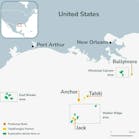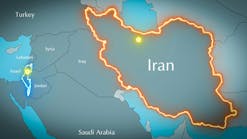A Lafayette, La., independent is preparing to expand carbon dioxide enhanced oil recovery operations after acquiring three southern Mississippi fields from Shell Oil Co. earlier this year.
The fields produce a combined 1,600 b/d of oil from Cretaceous Lower Tusca- loosa below 10,000 ft.
Little Creek, West Mallalieu, and Olive fields, operated by JP Oil Co., are fed by a 183 mile, 20 in. pipeline from Northeast Jackson Dome CO2 field in Rankin, Madison, and Scott counties.
Airgas Inc., Radnor, Pa., in mid-November was acquiring Shell Land & Energy Co.'s interests in Northeast Jackson Dome field and the pipeline, which extends as far as White Castle, La.
Shell let the contract for the pipeline in mid-1984 and planned to start injection in early 1986, about the time oil prices crashed.
CO2 EOR economics probably are acceptable with spot crude oil prices touching $25/bbl in mid-November, but sources knew of no new EOR projects under consideration along the pipeline.
EOR expansions
Scope exists to expand the high pressure CO2 cycling projects in Little Creek and West Mallalieu fields.
Current production from the fields is about 1,000 b/d at Little Creek, 350 b/d at West Mallalieu, and 250 b/d at Olive. Olive is considered fully developed but may have potential for further recovery with horizontal drilling, said Boyd Getz, JP exploration manager.
Little Creek field has 16 active CO2 injectors. JP sees opportunity for six more patterns the next 11/2 years on the field's west side, where most of the wells have been cleaned out and are ready for expansion.
The expansions will be installed pattern by pattern as the electrical costs of CO2 compression and reinjection allow, using existing and surplus field facilities. JP will scavenge some equipment from patterns that have reached their economic limit in terms of CO2:oil ratio.
JP also sees scope for as many as 10 new patterns the next 3-4 years on Little Creek's south side.
Meanwhile, West Mallalieu field has a greater reserve potential than Little Creek but many of its wells are plugged. JP sees a longer term project to reenter them. The field has four CO2 patterns.
CO2 supply facilities
The Northeast Jackson Dome assets, Shell's working interest about 98%, include one of the largest industrially-marketed underground CO2 reserves in the U.S. Remaining reserves exceed 2.2 tcf of CO2, including 900 bcf currently producing and 1.3 tcf nonproducing or behind pipe.
The 183 mile, 20 in., high pressure pipeline serves five major customers from Jackson Dome to White Castle. Revenues from these customers is $9.5 million/year from 21 bcf/year of CO2 deliveries, Airgas said.
Transported CO2 volumes are only about 15% of pipeline capacity. Shell takes no CO2 from the system, and no CO2 is currently moved between the southern Mississippi fields and White Castle, La.
Copyright 1996 Oil & Gas Journal. All Rights Reserved.


